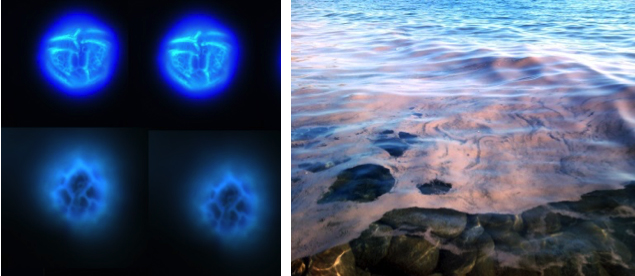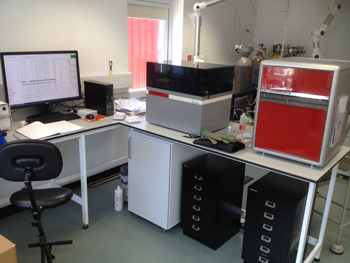Theme: Biodiversity & conservation
Surrounded by the sea, Scotland’s marine biodiversity is an important part of our natural heritage. We have ongoing projects supporting Scotland’s Marine Protected Area project and studying the effectiveness of protected areas in the UK and overseas. This work includes the study of the biology and distribution of protected species to identify which areas should be protected.
Harmful algae
We are seeking to explain causes for the increased occurrence and magnitude of phytoplankton blooms and harmful algal blooms in particular, in coastal ecosystems. Research based on field phytoplankton monitoring has so far focused on bloom drivers such as nutrient loading (Spatharis et al. 2007, 2009) and climate change (Spatharis et al. 2012).
Using laboratory experiments we try to establish the competitive ability and growth of harmful phytoplankton species under conditions of different light qualities, and nutrient availability. We focus on the causality and mechanisms involved in these processes using recent significant advancements of genetic tools (transcriptomic, epigenetic, functional genomic) and modelling approaches.

Contact: Dr Sofie Spatharis
Selected publications
- Carteron, A., Jeanmougin, M., Leprieur, F., and Spatharis, S. (2012)Assessing the efficiency of clustering algorithms and goodness-of-fit measures using phytoplankton field data. Ecological Informatics, 9, pp. 64-68. (doi:10.1016/j.ecoinf.2012.03.008)
- Spatharis, S., Dolapsakis, N.P., Economou-Amilli, A., Tsirtsis, G., and Danielidis, D.B. (2009) Dynamics of potentially harmful microalgae in a confined Mediterranean Gulf—assessing the risk of bloom formation. Harmful Algae, 8(5), pp. 736-743.(doi:10.1016/j.hal.2009.03.002)
- Spatharis, S., Danielidis, D.B., and Tsirtsis, G. (2007) Recurrent Pseudo-nitzschia calliantha (Bacillariophyceae) and Alexandrium insuetum (Dinophyceae) winter blooms induced by agricultural runoff. Harmful Algae, 6(6), pp. 811-822.(doi:10.1016/j.hal.2007.04.006)
Processes driving the diversity of coastal ecosystems
This research is focused on understanding the ecological processes that shape marine communities and sustain their diversity and productivity at both local (patch) and regional (metacommunity) scales (Spatharis et al. 2008, 2011a, Tamvakis et al. 2012, Spyropoulou et al. 2013).
Currently we are trying to establish the relative role of niche and neutral processes in shaping the morphological and genetic diversity of plankton. We combine different approaches including laboratory experimentations, mesocosm setups, field monitoring and numerical modelling.

Contact: Dr Sofie Spatharis
Selected publications
- Spyropoulou, A., Spatharis, S., Papantoniou, G., and Tsirtsis, G.(2013) Potential response to climate change of a semi-arid coastal ecosystem in eastern Mediterranean. Hydrobiologia, 705(1), pp. 87-99. (doi:10.1007/s10750-012-1384-6)
- Tamvakis, A., Miritzis, J., Tsirtsis, G., Spyropoulou, A., and Spatharis, S. (2012) Effects of meteorological forcing on coastal eutrophication: modeling with model trees. Estuarine, Coastal and Shelf Science, 115, pp. 210-217. (doi:10.1016/j.ecss.2012.09.003)
- Spatharis, S., Orfanidis, S., Panayotidis, P., and Tsirtsis, G. (2011)Assembly processes in upper subtidal macroalgae: the effect of wave exposure. Estuarine, Coastal and Shelf Science, 91(2), pp. 298-305.(doi:10.1016/j.ecss.2010.10.032)
- Spatharis, S., Mouillot, D., Danielidis, D.B., Karydis, M., Chi, T.D., and Tsirtsis, G. (2008) Influence of terrestrial runoff on phytoplankton species richness-biomass relationships: a double stress hypothesis. Journal of Experimental Marine Biology and Ecology, 362(1), pp. 55-62. (doi:10.1016/j.jembe.2008.06.003)
Biodiversity estimation & prediction
As part of our research on biodiversity indices we are developing integrated indices for assessing phytoplankton diversity and water quality, which are used for the implementation of the EU Water Framework Directive (Spatharis and Tsirtsis 2010, Spatharis et al. 2011b, Carteron et al. 2012).
We are also trying to optimise diversity prediction from abiotic variables, for example using machine learning techniques, to enable the testing of environmental change scenarios on the biodiversity of ecosystems (Tamvakis et al. 2014).

Contact: Dr Sofie Spatharis
Selected publications
- Tamvakis, A., Trygonis, V., Miritzis, J., Tsirtsis, G., and Spatharis, S. (2014) Optimizing biodiversity prediction from abiotic parameters. Environmental Modelling & Software, 53, pp. 112-120.(doi:10.1016/j.envsoft.2013.12.001)
- Carteron, A., Jeanmougin, M., Leprieur, F., and Spatharis, S. (2012)Assessing the efficiency of clustering algorithms and goodness-of-fit measures using phytoplankton field data. Ecological Informatics, 9, pp. 64-68. (doi:10.1016/j.ecoinf.2012.03.008)
- Spatharis, S., Roelke, D.L., Dimitrakopoulos, P.G., and Kokkoris, G.D.(2011) Analyzing the (mis)behavior of Shannon index in eutrophication studies using field and simulated phytoplankton assemblages. Ecological Indicators, 11(2), pp. 697-703.(doi:10.1016/j.ecolind.2010.09.009)
- Spatharis, S., and Tsirtsis, G. (2010) Ecological quality scales based on phytoplankton for the implementation of Water Framework Directive in the Eastern Mediterranean. Ecological Indicators, 10(4), pp. 840-847. (doi:10.1016/j.ecolind.2010.01.005)
Stable isotope applications to marine ecology
 Stable isotopes are powerful tracers for many processes in marine systems.
Stable isotopes are powerful tracers for many processes in marine systems.
In food web studies, carbon and nitrogen isotope ratios broadly record the source of primary production and trophic level respectively, thus allowing us to elucidate the structure of large food webs. For animals, the analysis of tissues with differing turnover time, and particularly those tissues such as hair or baleen that are grown incrementally, allow ecologists to track changes in diet in a species over time.
In addition, broad geographical differences in the isotope composition of the base of the marine food web also allows us to track the dispersal or migration of mobile species, which is particularly useful for cryptic species that are otherwise difficult to geolocate.
The NERC Life Sciences Mass Spectrometry Facility, located at the Scottish Universities Environmental Research Centre SUERC, provides access for UK scientists in the biological and environmental sciences to training and research facilities, offering a comprehensive suite of stable isotope techniques and expertise.
Contact: Jason Newton
Other staff involved in marine stable isotope analysis: Bob Furness, James Grecian, Dominic McCafferty, Ruedi Nager, Jason Newton and Rona McGill(both at SUERC); PhD student: Nina O'Hanlon
Selected publications
- Fleming N.E.C., Harrod C., Griffin D.C., Newton J. and Houghton J.D.R. (2014) Scyphozoan jellyfish provide short-term reproductive habitat for hyperiid amphipods in a temperate near-shore environment. Marine Ecology Progress Series 510, 229-240.
- Foote A.D., Newton J., Ávila-Arcos M.C., Kampmann M.-L., Samaniego J.A., Post K., Rosing-Asvid A., Sinding M.-H.S. and Gilbert M.T.P. (2013) Tracking niche variation over millenial timescales in sympatric killer whale lineages. Proceedings of the Royal Society B 280, 1768, 20131481.
- Zbinden J.A., Bearhop S., Bradshaw P., Gill B., Margaritoulis D., Newton J. and Godley B.J. (2010) Migratory dichotomy and associated phenotypic variation in marine turtles revealed by satellite tracking and stable isotope analysis. Marine Ecology Progress Series 421, 291-302.
- Votier S.C., Bearhop S., Witt M.J., Inger R., Thompson D. and Newton J. (2010) Individual responses of seabirds to commercial fisheries revealed using GPS tracking, stable isotopes and vessel monitoring systems. Journal of Applied Ecology, 47, 487-497.
- Mendes S., Newton J., Reid R.J., Zuur A.F. and Pierce G.J. (2007) d 13 C and d 15 N profiling of sperm whale teeth reveals ontogenetic movements and trophic ecology. Oecologia 151, 605-615.
Current projects
- Spatial variation in resource utilisation in gull populations with contrasting long-term population trajectories across south-west Scotland and Northern Ireland; PI Ruedi Nager, Glasgow
- The breeding implications of individual variation in wintering area and early territorial proficiency of great skuas Stercorarius skua in the Faroe Islands; PI Ruedi Nager, Glasgow
- Predator-prey interactions between spiny lobsters and chemotrophic clams; PI Martin Attrill, Plymouth
- Foraging ecology, niche variation and individual specialisation of brown skuas (Stercorarius lonnbergi); PI Richard Phillips, BAS
- Shark and other fish eye lenses: a window to cryptic life history behaviours; PI Clive Trueman, Southampton
- A hierarchical approach to the examination of the relationship between biodiversity and ecosystem service flows across coastal margins (CBESS); PI Mark Emmerson, Queens University Belfast

